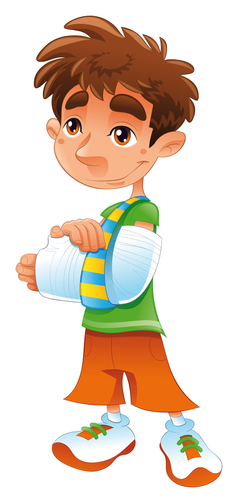Pediatric Bone Fracture
Pediatric Bone Fracture
Children can be very active and rough, and their favorite types of play may cause them to fracture a bone. Broken bones are common injuries in children because of their bone structure and growth plates, but they tend to occur more on the upper extremities because children try to catch themselves with their hands or arms as they fall. Fortunately, many pediatric bone fractures heal fully so that there is no lasting damage.
Common Causes of Broken Bones in Children

Children’s bones are still growing and developing, which means that their composition is different from the bones in adults. Children’s bones are more pliable and flexible, but they are still susceptible to injuries. Children also have growth plates to accommodate their growing bodies, and the growth plates can be damaged by fractures. Since children’s bones are soft, they can easily sustain fractures during their regular activities. They may break a bone as they try to prevent a fall, or they may sustain a fracture while playing their favorite sports. In most cases, pediatric bone fractures do not need surgery in order to heal properly. However, some severe breaks, such as those caused in car accidents, may require surgery so that the bone can be realigned and strengthened.
Types of Pediatric Bone Fractures
- Greenstick fractures – Greenstick fractures occur when a child’s bone bends in a manner that is similar to green wood that has been broken. The bend causes the bone to break on one side rather than completely through.
- Torus fractures – In a torus fracture, the bone has been twisted, buckled or weakened, but it has not broken. One side of the bone will bend, but the opposite side remains intact.
- Bend fractures – Bend fractures occur when the bone is bent but not broken.
- Complete fractures – When the break goes through the bone, it is a complete fracture. If the broken pieces remain in alignment, it is a non-displaced fracture. When the broken ends of the bone are not aligned properly, it is a displaced fracture.
When to Call a Doctor:
If you think that your child has broken a bone, then you should immediately call your doctor to schedule an appointment. You should remove the clothing around the injured area, and you may need to use scissors to cut the clothes away in order to avoid causing your child unnecessary pain. While you wait for your appointment, you can wrap some ice in a cloth and place it on the injury to reduce swelling. You may also want to avoid giving your child anything to eat in case surgery will be required to repair the fracture.
Call 911 Immediately When:
- Your child has fractured his neck or skull
- Your child’s bone has broken through the skin
Pediatric bone fractures are frightening for children and their parents, but SignatureCare Emergency Center has the tools, knowledge and skills necessary to comfort your family. We can X-Ray your child’s bones to determine the type and severity of the fracture, and our doctors can prescribe medicine that will make your child more comfortable as he heals. Our doors are open 24/7, which means that we are always available to help. If you think that your child has suffered a pediatric bone fracture, please Schedule an emergency room appointment with us.
- Alcohol Withdrawal Detox
- Allergic Reaction
- Asthma
- Abdominal Pain
- Causes of Abdominal Pain
- Bronchitis
- Back Pain
- Burns
- Chest Pain
- Cuts & Lacerations
- Dental Emergency
- Dehydration
- Fractures
- Head Injuries
- Heatstroke
- HIV
- Insect Bites and Stings
- Influenza
- Multi-slice CT Scan
- Seizure – Causes, When to Go to ER
- Tetanus Shots
- Ultrasound Imaging Services
- Migraine
- Pneumonia
- Skin Rash
- Vomiting and Diarrhea